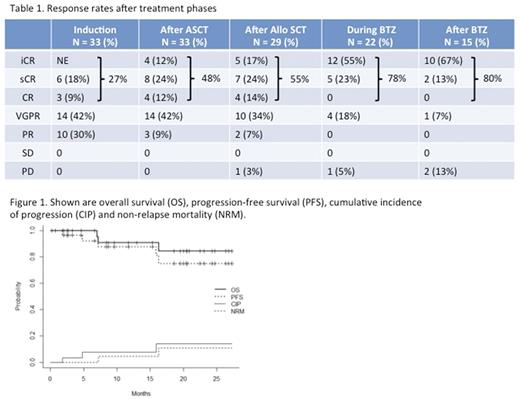Abstract

Introduction: Allogeneic stem cell transplantation (alloSCT) is the only curative treatment for newly diagnosed multiple myeloma (NDMM) patients but is hampered by a high incidence of relapse and chronic graft-versus-host disease (cGVHD). We hypothesized that bortezomib (BTZ) in consolidation after tandem autologous stem cell transplantation (ASCT) and nonmyeloablative (NMA) alloSCT could decrease the incidence of cGVHD while improving quality of response.
Method: NDMM patients ≤65 years with high-risk (HR) disease (defined as HR cytogenetics [del17p, t(4;14), t(14;16), t(14;20), del1p or gain 1q], ISS 3 or plasma cell leukemia) or ≤ 50 year regardless of risk status with an 8/8 HLA identical sibling or unrelated donor are eligible to participate in this prospective trial. After triplet BTZ-based induction chemotherapy and ASCT, outpatient NMA alloSCT is performed with either fludarabine 30 mg/m2 and cyclophosphamide 300 mg/m2 for 5 days (sibling donor) or fludarabine 30 mg/m2 for 3 days and total body irradiation 2 Gy (unrelated donor) followed by peripheral blood stem cell infusion. Acute GVHD (aGVHD) prophylaxis consists of tacrolimus and mycophenolate mofetil (MMF). BTZ is started on day +120 post-transplant at 1.3 mg/m2 every 2 weeks for 1 year. Response evaluation is based on IMWG criteria. Bone marrow minimal residual disease (MRD) evaluation is performed with highly sensitive (≥10-5) next-generation flow cytometry using 8-color Euroflow protocol before alloSCT, before BTZ, every 3 months for 2 years and at relapse. Immunophenotypic complete response (iCR) is defined as stringent CR in addition to 2 consecutive negative MRD results. aGVHD and cGVHD are evaluated according to modified Glucksberg and NIH criteria, respectively.
Results: As of 07/10/2017, 33 NDMM patients (16 males) have been enrolled; median age is 55 (range: 35-64) years. ISS 3 is found in 39%, Durie-Salmon stage 3A or 3B in 85%, HR cytogenetics in 58% (12% del17p, 15% t(4;14), 33% gain 1q21, 9% del1p and 12% with >1 HR cytogenetics). Induction consisted of CyBorD (79%) or VTD (21%) for a median of 4 (range: 4-7) cycles followed by ASCT. Median times from induction to ASCT and from ASCT to alloSCT are 5.7 and 4.4 months, respectively. Sibling donor transplants were performed in 42%. With a median follow-up of 15 months after alloSCT, 23 patients have started BTZ and received 96% of planned doses. No dose reduction was needed for toxicity. Consolidation BTZ improve depth of response, increasing ≥CR rate from 55% to 80% and iCR rate from 17% to 67% (Table 1), regardless of cytogenetic abnormalities. Median progression-free survival (PFS) is not reached; 12-month PFS is 87% (CI: 66-96) (Fig. 1). The cumulative incidence of progression at 12 months is 8%. Median overall survival (OS) is also not reached and 12-month OS is 91% (CI: 68-98). In 23 patients followed ≥6 months, cumulative incidences of grade II-IV and grade III-IV aGVHD are 30% and 15%, respectively. In 18 patients followed ≥12 months, the cumulative incidence of all grade and moderate-severe cGVHD at 12 months are 58% and 40%, respectively, with mostly mouth, skin and liver involvement. There is no clear association between time of occurrence of cGVHD and improvement of response. Three patients died, one from myeloma progression and 2 from grade III aGVHD, with a non-relapse mortality at 12 months of only 5%. Observed grade ≥3 non-hematologic toxicities possibly/related to BTZ include diarrhea (n=1), viral hemorrhagic cystitis (2 adenovirus, 1BK virus) and subclinical EBV reactivations (n=4).
Conclusion: Tandem ASCT-NMA alloSCT and BTZ consolidation result in a remarkably high rate of CR or better including iCR. Despite a HR NDMM population, a low relapse rate is observed. BTZ following alloSCT is safe and may contribute to decrease both the incidence of cGVHD or its severity.
Sebag: Celgene, Janssen: Consultancy. Cohen: University of Montreal: Patents & Royalties: royalties.
Author notes
Asterisk with author names denotes non-ASH members.

This icon denotes a clinically relevant abstract


This feature is available to Subscribers Only
Sign In or Create an Account Close Modal